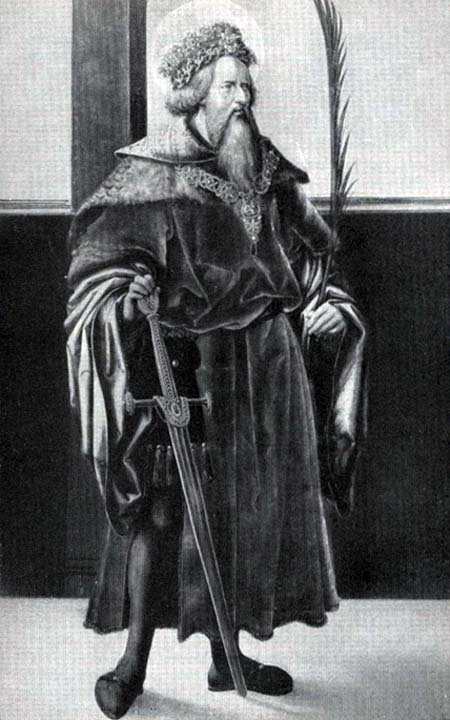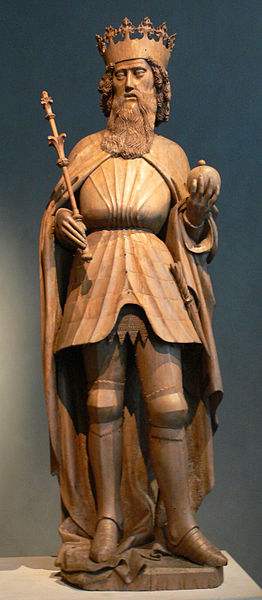 This saint was son of Gondebald, the Arian king of the Burgundians; but embraced the Catholic faith through the instructions of St. Alcimus Avitus, bishop of Vienne. (1) He succeeded to the kingdom of his father in 516, and in the midst of barbarism lived humble, mortified, penitent, devout, and charitable, even on the throne; a station in which the very name of true virtue is too often scarcely known. Before the death of his father, he built the famous monastery of St. Maurice at Agaune, in the Valais, in the year 515, where many holy hermits lived before that time in scattered cells.—God permitted this good prince to fall into a snare. He suffered his son Sigeric to be put to death, upon an accusation forged by his second wife, of a conspiracy against his life: but afterwards discovering the calumny, and pierced to the quick with remorse, he retired to Agaune, where he did penance in tears and sack-cloth.
This saint was son of Gondebald, the Arian king of the Burgundians; but embraced the Catholic faith through the instructions of St. Alcimus Avitus, bishop of Vienne. (1) He succeeded to the kingdom of his father in 516, and in the midst of barbarism lived humble, mortified, penitent, devout, and charitable, even on the throne; a station in which the very name of true virtue is too often scarcely known. Before the death of his father, he built the famous monastery of St. Maurice at Agaune, in the Valais, in the year 515, where many holy hermits lived before that time in scattered cells.—God permitted this good prince to fall into a snare. He suffered his son Sigeric to be put to death, upon an accusation forged by his second wife, of a conspiracy against his life: but afterwards discovering the calumny, and pierced to the quick with remorse, he retired to Agaune, where he did penance in tears and sack-cloth.

Statue of St. Sigismund of Burgundy, from the Freising Cathedral Altarpiece of 1443 and now in the Bavarian National Museum.
He made it his prayer to God that he might be punished in this life, to escape the divine vengeance in the next.—His prayer was heard:—for being taken prisoner by Chlodomir, the barbarous king of the Franks, he was, by his order, drowned in a well at Columelle, four leagues from Orleans, after he had reigned one year. His body was kept honourably at Agaune, till it was removed to the cathedral of Prague by the emperor Charles IV. (2) It has been famous for many miracles.
See St. Gregory of Tours, Hist. Fr. l. 3, c. 5 and 6; and Henschenius’s Collections, t. 1, Maij. p. 83.

______________________
Note 1. The Burgundians were a principal tribe of the Vandals, as Pliny and Zozimus assure us, and is further proved in the late history of Burgundy, and in L’Essai sur les premiers Rois de Bourgone, et sur l’Origine des Bourguignons, à Dijon, 4to. 1771. They are first met with on the banks of the Vistula, in Prussia. When Procopius wrote, on this side of the Elbe, below the Thuringi; in 407, they passed the Rhine into Gaul, and, under their first king, Gondicaire, in 413, conquered the country between the Upper Rhine, the Rhone, and the Saone, where they settled their kingdom, and shortly after extended its limits, so that it comprised what was afterwards the duchy of Burgundy, the Franche Comté, Provence, Lyonnois, Dauphiné, Savoye, &c., with the cities Geneva, Lyons, Autun, Basil, Nevers, Grenoble, Besançon, Langres, Viviers, Embrun, Vienne, Orange, Carpentras, Apt, &c. Gondicarius, the first king of the Burgundians, reigned fifty years, from 413 to 463, as appears from his letter to Pope Hilary, and that pope’s answer, in which he styles him his son, &c. Chilperic, his son, who succeeded him, was a zealous Catholic prince; but, having reigned about twenty-eight years, was assassinated with his wife, two sons, and brother Godomar, by his ambitious brother, Gondebald, who had embraced the Arian heresy. After a reign of twenty-five years, he died, in 516, leaving two sons, Sigismund and Godomar. He reformed the code of the Burgundian laws, called from him Loi Gombette. His brother Chilperic’s two daughters were brought up at his court at Geneva: Chrone, the eldest, took the religious veil, Clotildis, the second, was married to Clovis, king of the Franks, who waged war against him, to revenge the murder of Chilperic, and besieged him in Avignon, but afterwards made peace with him. Clodomir, king of Orleans, with his brothers, renewed this war against St. Sigismund, whom he took and caused to be drowned at Orleans, in 524. Clodomir pursued his brother and successor Godomar; but was defeated by him and slain. Ten years after, Clotaire and Childebert vanquished him, in 533, from which time the ancient kingdom of Burgundy was divided among the kings of the Franks. Among these, Gontran, son of Clotaire I. took the title of King of Burgundy, and reigned at Chalons sur Saone, though his brother Sigebert possessed a large part of that country. Childebert, son of Sigebert, in 523, and Thierri II. the son of Childebert, in 596, bore the same title. After the death of the latter, in 613, Burgundy lost its title of a kingdom in the hands of French monarchs; but was revived for a short time in Charles, youngest son of the Emperor Lothaire, with the title of King of Provence, afterwards of Arles. Upper Burgundy was called Franche Comté, because it owed only military service.
We find the Burgundians Christians and Catholics, under Gondicaire, soon after they had crossed the Rhine, and were settled in France. From Sozomen it appears that their conversion happened about the year 317. Those moderns who imagine them infected with Arianism almost as soon as they were Christians, are certainly mistaken. For it is manifest from Socrates, Nicephorus, Orosius, &c., that they remained zealous Catholics above a century and a half after their conversion to Christianity; not only to the year 440, fixed by Tillemont, but down to 491. They fell into Arianism only in the close of that century, and remained attached to that heresy no longer than about twenty years, during the reign of Gondebald, their third king. See Abrègè Chronologique de l’Hist. Eccl. Civile et Littèr, de Bourgogne, par M. Mille, 8vo. 1770.
Note 2. On this translation, see Henschenius, t. 1, Maij. p. 88.
The Lives of the Saints, Vol. V: May, by Rev. Alban Butler, New York, D.&J. Sadlier Publishers, 1866, pp.





